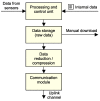Energy Harvesting Sources, Storage Devices and System Topologies for Environmental Wireless Sensor Networks: A Review
- PMID: 30060513
- PMCID: PMC6111894
- DOI: 10.3390/s18082446
Energy Harvesting Sources, Storage Devices and System Topologies for Environmental Wireless Sensor Networks: A Review
Abstract
The operational efficiency of remote environmental wireless sensor networks (EWSNs) has improved tremendously with the advent of Internet of Things (IoT) technologies over the past few years. EWSNs require elaborate device composition and advanced control to attain long-term operation with minimal maintenance. This article is focused on power supplies that provide energy to run the wireless sensor nodes in environmental applications. In this context, EWSNs have two distinct features that set them apart from monitoring systems in other application domains. They are often deployed in remote areas, preventing the use of mains power and precluding regular visits to exchange batteries. At the same time, their surroundings usually provide opportunities to harvest ambient energy and use it to (partially) power the sensor nodes. This review provides a comprehensive account of energy harvesting sources, energy storage devices, and corresponding topologies of energy harvesting systems, focusing on studies published within the last 10 years. Current trends and future directions in these areas are also covered.
Keywords: IoT; batteries; energy harvesting; energy storage; environmental monitoring; maintenance-free nodes; network topology; sensor network; solar power; supercapacitor; thermal power; wind power.
Conflict of interest statement
The authors declare no conflict of interest.
Figures









References
-
- Musilek P., Prauzek M., Kromer P., Rodway J., Barton T. Intelligent Energy Management for Environmental Monitoring Systems. Smart Sens. Netw. 2017:67–94. doi: 10.1016/B978-0-12-809859-2.00005-X. - DOI
-
- Prauzek M., Kromer P., Rodway J., Musilek P. Differential evolution of fuzzy controller for environmentally-powered wireless sensors. Appl. Soft Comput. J. 2016;48:193–206. doi: 10.1016/j.asoc.2016.06.040. - DOI
-
- Sundaran K., Murugaanandam S., Ganapathy V. Energy efficient techniques in wireless sensor networks: Recent survey. Sens. Lett. 2016;14:643–655. doi: 10.1166/sl.2016.3588. - DOI
-
- Prauzek M., Musilek P., Watts A. Fuzzy algorithm for intelligent wireless sensors with solar harvesting; Proceedings of the 2014 IEEE Symposium Series on Computational Intelligence; Orlando, FL, USA. 9–12 December 2014; pp. 1–7.
-
- Shaikh F.K., Zeadally S. Energy harvesting in wireless sensor networks: A comprehensive review. Renew. Sustain. Energy Rev. 2016;55:1041–1054. doi: 10.1016/j.rser.2015.11.010. - DOI
LinkOut - more resources
Full Text Sources
Other Literature Sources
Miscellaneous

